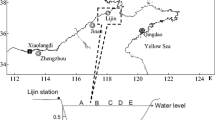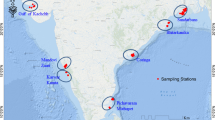Abstract
The distribution and geochemical behavior of nonylphenol (NP) in suspended and settling particles were studied in Lake Biwa, Japan. The vertical distribution of the particulate nonylphenol (PNP)/particulate organic carbon (POC) ratio showed a characteristic and hitherto unreported profile. The ratio was low at the surface, increased with depth to the middle layer before reaching a maximum at a depth of 45 or 65 m, and decreased toward the bottom. This profile is thought to have been due to the particulate organic matter (POM) in the lake being either freshly produced or aged POM and because the aged POM has a relatively higher affinity for NP compared to freshly produced POM. This idea was supported by the statistical analysis of physicochemical data (PNP, POC and chlorophyll a) and because the average PNP/POC ratio in the aged POM (2.24 × 10−5 g/g) was approximately four times higher than that of the freshly produced POM (0.63 × 10−5 g/g). The settling flux was estimated to be 2.2–6.4 μg/m2/day.



Similar content being viewed by others
References
Ahel, M. (1987). Biogeochemical behaviour of alkylphenol polyethoxylates in the aquatic environment. Ph D Thesis University of Zagreb Croatia. pp. 200.
Ahel, M., & Giger, W. (1993). Partitioning of alkylphenols and alkylphenol polyethoxylates between water and organic solvents. Chemosphere, 26, 1471–1478. doi:10.1016/0045-6535(93)90214-P.
Ahel, M., Giger, W., & Schaffner, C. (1994). Behaviour of alkylphenol polyethoxylate surfactants in the aquatic environment––II. Occurrence and transformation in rivers. Water Research, 28, 1143–1152. doi:10.1016/0043-1354(94)90201-1.
Ball, H. A., Reinhard, M., & McCarty, P. L. (1989). Biotransformation of halogenated and nonhalogenated octylphenol polyethoxylate residues under aerobic and anaerobic conditions. Environmental Science & Technology, 23, 951–961. doi:10.1021/es00066a004.
Blackburn, M. A., Kirby, S. J., & Waldock, M. J. (1999). Concentrations of alkylphenol polyethoxylates entering UK estuaries. Marine Pollution Bulletin, 38, 109–118. doi:10.1016/S0025-326X(98)00104-0.
Bolz, U., Hagenmaier, H., & Körner, W. (2001). Phenolic xenoestrogens in surface water, sediments, and sewage sludge from Baden-Württemberg, south-west Germany. Environmental Pollution, 115, 291–301. doi:10.1016/S0269-7491(01)00100-2.
Brunner, P. H., Capri, S., Marocomini, A., & Giger, W. (1988). Occurrence and behavior of linear alkylbenzensulphonates, nonylphenol, nonylphenol mono- and nonylphenol diethoxylates in sewage and sewage sludge treatment. Water Research, 22, 1465–1472. doi:10.1016/0043-1354(88)90157-1.
Cloern, J. E., Grenz, C., & Vidergar-Lucas, L. (1995). An empirical model of the phytoplankton chlorophyll: carbon ratio - the conversion factor between productivity and growth rate. Limnology and Oceanography, 40, 1313–1321.
Comber, M. H. I., Williams, T. D., & Stewart, K. M. (1993). The effects of nonylphenol on Daphnia magna. Water Research, 27, 273–276. doi:10.1016/0043-1354(93)90086-W.
Elser, J. M., Foster, D. K., & Hecky, R. E. (1995). Effects of zooplankton on sedimentation in pelagic ecosystems: Theory and test in two lakes of the Canadian shield. Biogeochemistry, 30, 143–170. doi:10.1007/BF02186411.
Giger, W., Stephanou, E., & Schaffner, C. (1981). Persistent organic chemicals in sewage effluents, I. Identifications of nonylphenols and nonylphenolethoxylates by glass capillary gas chromatography/mass spectrometry. Chemosphere, 10, 1253–1263. doi:10.1016/0045-6535(81)90042-4.
Giger, W., Brunner, P. H., & Schaffner, C. (1984). 4-nonylphenol in sewage sludge, accumulation of toxic metabolites from nonionic surfactants. Science, 225, 623–625. doi:10.1126/science.6740328.
Hale, R. C., Smith, C. L., de Fur, P. O., Harvey, E., Bush, E. O., La Guardia, M. J., et al. (2000). Nonylphenols in sediments and effluents associated with diverse wastewater outfalls. Environmental Toxicology and Chemistry, 19, 946–952. doi:10.1897/1551-5028(2000)019<0946:NISAEA>2.3.CO;2.
Hu, J., Wan, Y., Shao, B., Jin, X., An, W., Jin, F., et al. (2005). Occurence of trace organic Contaminants in Bohai Bay and its adjacent Nanpaiwu River, North China. Marine Chemistry, 95, 1–13.
Isobe, T., Nishiyama, H., Nakashima, A., & Takada, H. (2001). Distribution and behavior of nonylphenol, octylphenol, and nonylphenol monoethoxylate in Tokyo metropolitan area, Their association with aquatic particles and sedimentary distributions. Environmental Science & Technology, 35, 1041–1049. doi:10.1021/es001250i.
Jin, F., Hu, J., Liu, J., Yang, M., Wang, F., & Wang, H. (2008). Sequestration of nonylphenol in sediment from Bohai Bay, North China. Environmental Science & Technology, 42, 746–751. doi:10.1021/es071522i.
Jobling, S., & Sumpter, J. P. (1993). Detergent components in sewage effluent are weakly oestrogenic to fish; An in vitro study using rainbow trout (Oncorhynchus mykiss) hepatocytes. Aquatic Toxicology (Amsterdam, Netherlands), 27, 361–372. doi:10.1016/0166-445X(93)90064-8.
Jobling, S., Sheahan, D., Osborne, J. A., Matthiessen, P., & Sumpter, J. P. (1996). Inhibition of testicular growth in rainbow trout (Oncorhynchus mykiss) exposed to estrogenic alkylphenolic chemicals. Environmental Toxicology and Chemistry, 15, 194–202. doi:10.1897/1551-5028(1996)015<0194:IOTGIR>2.3.CO;2.
Kveštak, R., & Ahel, M. (1994). Occurrence of toxic metabolites from nonionic surfactants in the Krka river estuary. Ecotoxicology and Environmental Safety, 28, 25–34. doi:10.1006/eesa.1994.1031.
Li, D., Kim, M., Oh, J.-R., & Park, J. (2004a). Distribution characteristics of nonylphenols in the artificial Lake Shihwa, and surrounding creeks in Korea. Chemosphere, 56, 783–790. doi:10.1016/j.chemosphere.2004.01.008.
Li, Z., Li, D., Oh, J.-R., & Je, J.-G. (2004b). Seasonal and spatial distribution of nonylphenol in Shihwa Lake, Korea. Chemosphere, 56, 611–618. doi:10.1016/j.chemosphere.2004.04.022.
Lorenzen, C. J. (1967). Determination of chlorophyll and pheo-pigments, spectrophotometric equations. Limnology and Oceanography, 12, 343–346.
Lye, C. M., Frid, C. L. J., Gill, M. E., Cooper, D. W., & Jones, D. M. (1999). Estrogenic alkylphenols in fish tissues, sediments, and waters from the U.K. Tyne and Tees estuaries. Environmental Science & Technology, 33, 1009–1014. doi:10.1021/es980782k.
MLITT (Ministry of Land, Infrastructure, Transport and Tourism, Japan), 1999. Survey report for endocrine disruption substances in water environment, 1999, Tokyo (in Japanese).
MLITT (Ministry of Land, Infrastructure, Transport and Tourism, Japan), 2000. Survey report for endocrine disruption substances in water environment, 2000, Tokyo (in Japanese).
MLITT (Ministry of Land, Infrastructure, Transport and Tourism, Japan), 2001. Survey report for endocrine disruption substances in water environment, 2001, Tokyo (in Japanese).
Nakamura, Y. (1998). Nonionic surfactants—History, kind and property and use. Journal of Japanese Society for Water Environment, 21, 192–196 in Japanese.
Renner, E. (1997). European bans trigger transatlantic debate. Environmental Science & Technology, 31, 316–320.
Routledge, E. J., & Sumpter, J. P. (1996). Estrogenic activity of surfactants and some of their degradation products assessed using a recombinant yeast screen. Environmental Toxicology and Chemistry, 15, 241–248. doi:10.1897/1551-5028(1996)015<0241:EAOSAS>2.3.CO;2.
Sugiyama, M., Hori, T., Kihara, S., & Matsui, M. (2005). Geochemical behavior of trace elements in Lake Biwa. Limnology, 6, 117–130. doi:10.1007/s10201-005-0144-y.
Tezuka, Y. (1985). C:N:P ratios of seston in Lake Biwa as indicators of nutrient deficiency in phytoplankton and decomposition process of hypolimnetic particulate matter. Japanese Journal of Limnology, 46, 239–246.
Tsuda, T., Takino, A., Muraki, K., Harada, H., & Kojima, M. (2001). Evaluation of 4-nonylphenols and 4-tert-octylphenol contamination of fish in rivers by laboratory accumulation and excretion experiments. Water Research, 35, 1786–1792. doi:10.1016/S0043-1354(00)00445-0.
Tsuda, T., Suga, K., Kaneda, E., & Ohsuga, M. (2002). 4-Nonylphenol, 4-nonylphenol mono- and diethoxylates, and other 4-alkylphenols in water and shellfish from rivers flowing into Lake Biwa. Bulletin of Environmental Contamination and Toxicology, 68, 126–131. doi:10.1007/s00128-001-0228-2.
VanRy, D. A., Dachs, J., Gigliotti, C. L., Brunciak, P. A., Nelson, E. D., & Eisenreich, S. J. (2000). Atmospheric Seasonal trends and environmental fate of alkylphenols in the lower Hudson River Estuary. Environmental Science & Technology, 34, 2410–2417. doi:10.1021/es9910715.
Watanabe, M., Nakashima, E., Nakatani, N., Yamazaki, H., & Sakugawa, H. (2004). Distribution, behavior and historical trend of nonylphenol in Hiroshima Bay, Japan. Chikyukagaku (Geochemistry), 38, 17–27 in Japanese.
White, R., Jobling, S., Hoare, S. A., Sumpter, J. P., & Parker, M. G. (1994). Environmentally persistent alkylphenolic compounds are estrogenic. Endocrinology, 135, 175–182. doi:10.1210/en.135.1.175.
Yamashita, N., Kannan, K., Imagawa, T., Villeneuve, D., Hashimoto, S., Miyazaki, A., et al. (2000). Vertical profile of polychlorinated dibenzo-p-dioxins, dibenzofurans, naphthalenes, biphenyls, polycyclic aromatic hydrocarbons, and alkylphenols in a sediment core from Tokyo bay, Japan. Environmental Science & Technology, 34, 3560–3567. doi:10.1021/es001043i.
Yoshimizu, Y., Yoshida, T., Nakanishi, M., & Urabe, J. (2001). Effects of zooplankton on the sinking flux of organic carbon in Lake Biwa. Limnology, 2, 37–43. doi:10.1007/s102010170014.
Acknowledgements
This study was partly supported by grants from the Japan Society for the Promotion of Science (12480150 and 15651028) and from Nippon Life Insurance Foundation. The authors thank Mr. T. Koitabashi and Mr. T. Miyano from the Center for Ecological Research at Kyoto University for their cooperation with the collection of samples in Lake Biwa.
Author information
Authors and Affiliations
Corresponding author
Rights and permissions
About this article
Cite this article
Yoshida, H., Kudari, S., Hori, T. et al. Distribution of Particulate Nonylphenol in Lake Biwa, Japan. Water Air Soil Pollut 200, 267–276 (2009). https://doi.org/10.1007/s11270-008-9910-x
Received:
Accepted:
Published:
Issue Date:
DOI: https://doi.org/10.1007/s11270-008-9910-x




